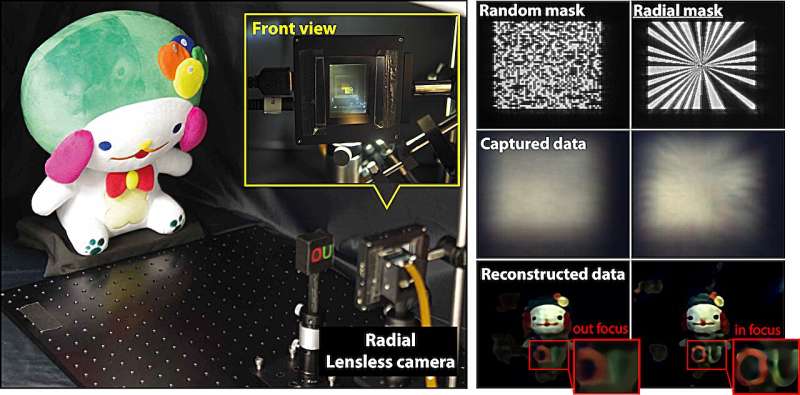This article has been reviewed according to Science X's editorial process and policies. Editors have highlighted the following attributes while ensuring the content's credibility:
fact-checked
trusted source
proofread
Looking near and far without a lens: Radial masks give thin cameras a large depth of field

To take an image that is completely in focus, one of the most familiar parts of a camera—the lens—isn't necessary anymore. Instead, a thin mask over the image sensor can do the job. But the kind of mask you use makes a huge difference in how sharp your image is.
In a study published recently in IEEE Transactions on Computational Imaging, researchers from Osaka University have described an optimized radial-coded mask with extended depth of field to sharpen objects in both the foreground and background of images.
As camera designs have become thinner and lighter, one of the main limitations has been the lens, which has to be a certain size, shape, and distance from the image sensor to focus light onto it. In lensless cameras, the sensor takes a blurry image and does the work to "focus" the image afterward using reconstruction software. It's able to do this because the information needed to extract the image is encoded in the interaction between light and the mask in front of the sensor, which is called the point spread function.
One of the advantages of a lensless camera is that, by altering its mask in an intentional way, the camera's characteristics can be changed. For instance, its depth of field can be altered, as was done in this study. In conventional lensless cameras, the point spread function changes depending on the distance of the subject, and the camera can only clearly capture subjects at a certain distance in a single reconstruction process.
The researchers wanted to create a lensless camera that could focus better on both foreground and background objects. That is, they wanted a camera with a large depth of field, and they found a mask with sections emanating from the center like the rays of a starburst would do the trick.
The Intelligent Media Systems group, who conducted the research at Osaka University, found that the number of sections and their thicknesses also change the characteristics. More and thinner sections highlight fine details, whereas fewer, thicker ones focus on smooth regions. Hence, the team used an optimization process to determine the mask that would work the best for all parts and found that a specific combination of thin and thicker sections was best.
The masks were tested using simulation and an actual prototype, and it was found that the depth of field was indeed extended.
Lensless cameras are smaller, thinner, and lighter than traditional cameras, and increasing the depth of field is a huge step toward developing a device that can be used in real applications such as medicine and industrial inspection. In addition, there are still many other types and arrangements of masks to explore, and this could make lensless cameras a practical and common device in the future.
More information: José Reinaldo Cunha Santos A. V. Silva Neto et al, Extended Depth-of-Field Lensless Imaging Using an Optimized Radial Mask, IEEE Transactions on Computational Imaging (2023). DOI: 10.1109/TCI.2023.3318992




















